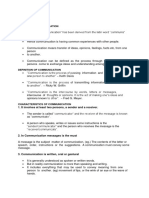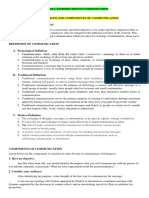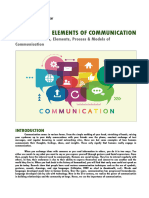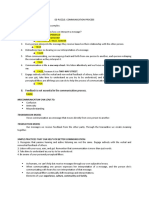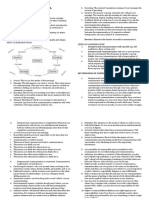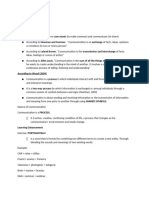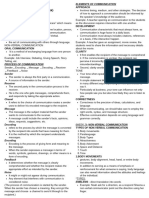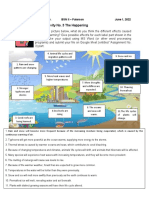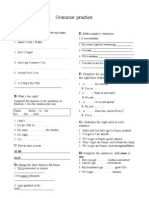Lesson 1: Communication Processes: Message/Code
Lesson 1: Communication Processes: Message/Code
Uploaded by
꧁ΛПGΣᄂ꧂Copyright:
Available Formats
Lesson 1: Communication Processes: Message/Code
Lesson 1: Communication Processes: Message/Code
Uploaded by
꧁ΛПGΣᄂ꧂Original Title
Copyright
Available Formats
Share this document
Did you find this document useful?
Is this content inappropriate?
Copyright:
Available Formats
Lesson 1: Communication Processes: Message/Code
Lesson 1: Communication Processes: Message/Code
Uploaded by
꧁ΛПGΣᄂ꧂Copyright:
Available Formats
Lesson 1:
Communication Processes
COMMUNICATION
▪ comes from the Latin word, “Communis”, and
“Communicare” . “Communis” is a noun word, Message/Code
which means common, communality or sharing. ▪ It is the idea, information, view, fact, feeling,
etc. that is generated by the sender and is then
▪ “Communicare” is a verb, which means to intended to be communicated further.
make something common. means of sending or
receiving information, such as telephone lines Channel/Medium
or computers. describes the process of ▪ It is the pathway or device wherein messages
exchanging of information between people, for pass through. ▪ The five senses are significant to
example by means of speaking, writing, or using pass through. ▪ Other methods can be done
a common system of signs or behavior. through face-to-face communication, letter
writing, through a telephone or cellular phone,
COMMUNICATION PROCESS a public address using print and social media.
- cyclical manner of sending and receiving Feedback
messages and vice versa as a response or ▪ the result of the interaction between the
feedback from the previous message in the sender and the decoder. In here, the decoder
form of ideas, thoughts, feelings, opinions is gives a response to the message conveyed. As
transmitted between two or more persons with the communication process progresses, the
the intent of creating a shared understanding speaker becomes the decoder too. Each party in
which follows a course and has progression. the communication process continuously sends
message to the other.
ELEMENTS OF COMMUNICATION
Feedback serves as an assessment
Source/Encoder on how the receiver interprets each
▪ Holds the fulcrum of the communication message:
▪ The sender or the communicator generates ▪ Negative Feedback
the message and conveys it to the receiver. happens when there is lack of understanding
▪ He is the source and the one who starts the ▪ Positive Feedback
communication (usually) using past takes place when the receiver full understands
experiences, thoughts, perceptions, and the message. Although it may not fully agree
feelings. with the source as the message is interpreted
precisely.
Receiver/Decoder ▪ Ambiguous Feedback
▪ He is the person who is last in the chain and occurs when the message relayed is not very
for whom the message was sent by the sender. clear thereby giving confusion to the receiver.
Once the receiver receives the message and
understands it in proper perspective and acts Context
according to the message, only then the This refers to the circumstances - situation,
purpose of communication is successful. condition, environment where communication
occurs. The way you express messages will
depend upon whom you are talking to
Communication Noise A. Intrapersonal Communication
refers to influences on effective communication ❑ Communication express through self-talk.
that influence the interpretation of ❑ Involves personal thoughts and emotions.
conversations. Classified as: ❑ Feedback goes back to you
a. EXTERNAL NOISE
b. INTERNAL NOISE B. Interpersonal Communication
c. SEMANTIC NOISE ❑ Communication between two people
(dyadic) or small group of individuals (small
a. EXTERNAL NOISE group discussion)
originates from the communicators'
❑ Allows the speakers to discuss topics that
environment. ex. physical noise, laughter, the
interest them, or they may share a common
videoke sessions in the neighborhood.
bond with each other.
b. INTERNAL NOISE
Includes anything that is self-related attitudes,
C. Public Communication
opinions, beliefs that hamper effective
❑ One person is speaking in front of an
communication. ex. hunger, and pain out of
audience o the magnitude or size may be
illness psychological thoughts like - worry,
limited or numerous.
anxiety, disappointments. Etc.
❑ The speaker delivers the message in a formal
c. SEMANTIC NOISE
When the sender and receiver do not share the setting, giving a topic that is thematic.
same meanings for their verbal and nonverbal ❑ Feedback from the audience may be
signals. Understanding a particular word or available o Components: speaker, speech, and
gesture differently from that of the person you audience .
are speaking can create this noise.
D. Mass Communication
Frame of Reference ❑ Communication takes place through a
Communicators bring into their interactions technology such as the social network/internet,
their own value system or culture, preference, television, radio, and newspaper.
world views, self-concept, expectations, and ❑ The message is replicated many times,
experiences. resulting to a multiplier effect to the receivers.
Speakers must be a very careful of the kind of
TYPES OF COMMUNICATION information being disseminated. The message
▪ I. Verbal Communication conveyed must be screened prior to public
▪ II. Non-Verbal Communication dissemination.
I. Verbal Communication Adler & Rodman (2006)
includes the use of symbols that have universal ▪ First mass message is aimed at a large
meanings and can be classified as spoken or audience without any personal contact between
written can be done through intrapersonal, sender and receivers.
interpersonal, public, and mass communication. ▪ Second, most of the messages sent via mass
communication channels are developed, or at
KINDS of VERBAL COMMUNICATION least financed, by large organizations.
A. Intrapersonal Communication ▪ Less personal and more than a product.
B. Interpersonal Communication ▪ Always controlled by many gatekeepers who
C. Public Communication determine what message will be delivered to
D. Mass Communication
consumers, how they will be constructed, and Manifested to evoke certain emotions such as
when they will be delivered. happy joyful, sad, frustration, and many other
facial movements.
II. Non-Verbal Communication D. Paralanguage
Non-verbal communication is communication ❑ Detected in loud, or faint sound to provide
without words because written words are authority or emphasis to the volume of the
perceived to be verbal, but there is a lack of words.
sound element. Hence, words in non-verbal ❑ Volume, Pitch, Speaking Rate, and Voice
communication is not included. Therefore, non- Quality
verbal gestures, eye movements, tone of voice, E. Touch
the use of space and touch. Because these ❑ Can be hug, kiss, handshake
Languages, Literature, and Communication Page ❑ In the new normal, elbow toss can be
11 non-verbal cues are not shared universally, applied.
they may give a different meaning to another F. Space and Distance
culture and thus, considered as ambiguous. ❑ Indicates the importance of a person.
❑ Distance signifies the intimacy and personal
Adler & Rodman, 2006 acceptance in some cultures.
• “Nonverbal communication performs a third
G. Clothes and Personal Appearance
valuable social function: conveying emotions
❑ Provide a quick personal surveillance of the
that we may be unwilling or unable to express ─
person’s age, interest, personality, sex, attitude,
or ones we may not even aware of. In fact,
social standing, or religious affiliation.
nonverbal communication is much better suited
H. Symbols
to expressing attitudes and feelings than ideas”.
• can be in silence, Body Language (gesture), ❑ General graphic presentation so that people
Facial Expression, Paralanguage or use of voice, will be guided accordingly such as traffic signs,
Touch (hug, kiss, handshake), Space and mathematical problems, medical, and other
Distance, Clothes and Personal Appearance, and fields of specialty (Rasel, 2013) .
Symbols ❑ Something that represent something else.
A. Silence III. Forms of Communication
▪ Conveys meanings to the spectators that can A. Formal Communication
be seen in a person who is quiet yet busy, a Involve the use of public speaking or mass
person who is contemplating, grieving, not to communication, a combination of both verbal
be disturbed or being in a difficult situation. In a and nonverbal messages. Language is more
conversation between two individuals, a silent precise as the speaker is careful with grammar.
reply may signify the receiver does not A dress code, proper posture, and eye contact
understand or may refuse to answer. are being taken into consideration.
B. Body Language B. Informal Communication
▪ Unconscious movement – tell the state of Involves interpersonal and small group
emotion the person is undergoing such as discussion where people can be at ease and be
walking around for being bored, biting the more comfortable. During the interaction, less
fingernails for being nervous, or other activities attention is given to nonverbal cues like
done unconsciously. clothing, posture, and eye contact.
▪ Conscious movement - entails individuals to
render the designated actions to be rendered IV. Functions of Communication
for specific purposes. 1. Informing and Conveying the Message
C. Facial Expression
2. Persuading ideas, opinions, and suggestions 2. COMMUNICATION NECESSITATES
3. Integrating divisions and departments by NEGOTIATION OF MEANINGS OF
building a communication network SYMBOLS
4. Creating and establishing relationships - two-way negotiation specifies that
5. Helping in decision making communication use or negotiate the meanings
6. Reducing misunderstanding and resolving of verbal and non-verbal.
troubles - each participant in the communication has
different frame of reference(background,
CHARACTERISTICS OF assumptions, and cultures).
COMMUNICATION 3.COMMUNICATION IS CONTEXTUAL
- reflected in the definitions and stressed of
1. COMMUNICATION IS A PROCESS transactional model occurs in a context
2. COMMUNICATION NECESSITATES
NEGOTIATION OF MEANINGS OF SYMBOLS 3 GENERAL TYPES OF CONTEXTS:
3. COMMUNICATION IS CONTEXTUAL A. PSYCHOSOCIAL CONTEXT
4. THE GOAL OF COMMUNICATION IS SHARED B. LOGISTICAL CONTEXT
UNDERSTANDING C. INTERACTIONAL CONTEXT
1. COMMUNICATION IS A PROCESS A. PSYCHOSOCIAL CONTEXT
-There is a transmission of thoughts, ideas, and - draws interaction among emotional history,
emotions. Communication follows a course and social relationship, and cultural capital of the
has progression. participants
3 MODELS OF COMMUNICATION B. LOGISTICAL CONTEXT
1. Linear Model the physical characteristics of a particular
2. Interactive Model communication situation in terms of its time,
3.Transactional Model place, setting, and occasion relating to or
involving organization and planning.
1. LINEAR MODEL
- Communication as one-way or linear C. INTERACTIONAL CONTEXT
transmission of messages. - various composition or classifications of
-project an active sender and passive receiver interaction dictate the style of communication
- interaction model of communication
2. INTERACTIVE MODEL describes communication as a process in which
-a two-way process communication because it participants alternate positions as sender and
recognizes the presence of feedback receiver and generate meaning by sending
-has added concept "FIELD OF EXPERIENCE" messages and receiving feedback
-acknowledges the people integrated into the
communication process 4. THE GOAL OF COMMUNICATION
IS SHARED UNDERSTANDING
3. TRANSACTIONAL MODEL - entails the participants in the communication
Emphasizes a conscious interaction between process have achieved common, mutual, or
the sender and the receiver to create meaning shared understanding of the subject matter/s
and arrive at a common understanding of the comprised of the thoughts and emotions
information. involved in the process.
You might also like
- No 3.middle School My Brother Is A Big, Fat LiarDocument251 pagesNo 3.middle School My Brother Is A Big, Fat Liarmaya aliNo ratings yet
- Dale Carnegie - High Impcat PresentationsDocument4 pagesDale Carnegie - High Impcat Presentationstaiichiohno100% (3)
- OSHA Process Safety ManagementDocument18 pagesOSHA Process Safety ManagementShafiqah Samsuri100% (1)
- Test Bank For Leadership Enhancing The Lessons of Experience 6th Edition by Richard L Hughes PDFDocument22 pagesTest Bank For Leadership Enhancing The Lessons of Experience 6th Edition by Richard L Hughes PDFHeba Sami100% (1)
- Purposive Communication For Academic PurposesDocument8 pagesPurposive Communication For Academic Purposesrosalyn dumalag100% (7)
- COmmunication For B. Ed NotesDocument7 pagesCOmmunication For B. Ed NotesManoj Yadav83% (12)
- CP 206 SCM Rough PDFDocument37 pagesCP 206 SCM Rough PDFKumardeep SinghaNo ratings yet
- Rubric For Human Impact ProjectDocument2 pagesRubric For Human Impact ProjectJohn OsborneNo ratings yet
- Lesson 1 PCOMDocument4 pagesLesson 1 PCOMalyssamaeacosta44No ratings yet
- Oral Communication in ContextDocument7 pagesOral Communication in ContextsunnxkimNo ratings yet
- Communication Handout PDFDocument3 pagesCommunication Handout PDFDamienNo ratings yet
- Unit 1-Theory of CommunicationDocument46 pagesUnit 1-Theory of Communicationdogecod607No ratings yet
- Purposive CommunicationDocument14 pagesPurposive CommunicationAljen Joseph SuzaraNo ratings yet
- Major Elements of CommunicationDocument2 pagesMajor Elements of CommunicationAlexDomingoNo ratings yet
- Communication: PurposiveDocument77 pagesCommunication: Purposiveannyeong_123No ratings yet
- GE5Document22 pagesGE5Aries C. GavinoNo ratings yet
- J. Paul LeaganDocument15 pagesJ. Paul LeaganAries C. GavinoNo ratings yet
- COMMUNICATIONDocument3 pagesCOMMUNICATIONhakdoghakdog84No ratings yet
- Lesson 1 - Definition, Levels, & ProcessDocument40 pagesLesson 1 - Definition, Levels, & ProcessanneNo ratings yet
- Lesson 1 OutlineDocument5 pagesLesson 1 OutlineXHYRICH ISLETANo ratings yet
- Compiled Lectures in CPCDocument54 pagesCompiled Lectures in CPCHarelyn LeponNo ratings yet
- Midterm Reviewer For Purposive CommunicationDocument4 pagesMidterm Reviewer For Purposive CommunicationAnne RiegoNo ratings yet
- Purposive Communication, Introduction To CommunicationDocument4 pagesPurposive Communication, Introduction To Communicationanggelia25anggelesNo ratings yet
- Introduction To Communication SA AJ-3pptxDocument20 pagesIntroduction To Communication SA AJ-3pptxHalah AftabNo ratings yet
- WEEKS 1-3 Nature and Elements of CommunicationDocument18 pagesWEEKS 1-3 Nature and Elements of Communicationwowers122No ratings yet
- Purcomm Notes Wk1 To Wk7Document16 pagesPurcomm Notes Wk1 To Wk7Jenny GarciaNo ratings yet
- Ge 107 ReviewerDocument4 pagesGe 107 ReviewerMONTANCES, MARIZ L.No ratings yet
- Topic 1Document2 pagesTopic 1KARLA VANESSA NABORNo ratings yet
- Oral Com ReviewerDocument4 pagesOral Com ReviewerperaltadhannieNo ratings yet
- 1 Definition of CommunicationDocument52 pages1 Definition of CommunicationZhanine Grace SambranoNo ratings yet
- Purposive Communication (Part 1) Purposive Communication (Part 1)Document14 pagesPurposive Communication (Part 1) Purposive Communication (Part 1)Ice PrincessNo ratings yet
- Purc ReviewerDocument7 pagesPurc ReviewerJhay Ar AuguisNo ratings yet
- Purposive Communication (Part 1) Purposive Communication (Part 1)Document14 pagesPurposive Communication (Part 1) Purposive Communication (Part 1)Tricia Mae Comia AtienzaNo ratings yet
- PURC111Document3 pagesPURC111wooziwaegNo ratings yet
- MIL 1ST QUARTER REVIEWERDocument11 pagesMIL 1ST QUARTER REVIEWERoliveNo ratings yet
- Reviewer in Oral Communication in ContextDocument27 pagesReviewer in Oral Communication in ContextJean DaclesNo ratings yet
- Gec 5 ReviewahDocument20 pagesGec 5 ReviewahAllaika Zyrah FloresNo ratings yet
- Eng 111 NotesDocument15 pagesEng 111 Notesproxima midnightxNo ratings yet
- Note Taking Cor 001Document14 pagesNote Taking Cor 001Clitz Myle Ochea YmbongNo ratings yet
- NGEC 5A Handouts PrelimDocument15 pagesNGEC 5A Handouts Prelimliftjohndemonteverde061618No ratings yet
- Oral Communication 2024Document17 pagesOral Communication 2024nada01383No ratings yet
- Get To Know Me Better!Document154 pagesGet To Know Me Better!Marc BarcoberoNo ratings yet
- 1st Semester Q1 Oral Communication (Notes)Document4 pages1st Semester Q1 Oral Communication (Notes)vince.resultay07No ratings yet
- Oral Com Quiz BeeDocument14 pagesOral Com Quiz BeeAllysah Aloc KimNo ratings yet
- Hand OutDocument6 pagesHand OutGevelyn BautistaNo ratings yet
- Lesson 1 PcomDocument5 pagesLesson 1 Pcomchristiandomenden16No ratings yet
- Lesson 1 Communication Communication: GNED05Document2 pagesLesson 1 Communication Communication: GNED05jasmir.amerNo ratings yet
- Oral Com 1ST Quarter LessonsDocument9 pagesOral Com 1ST Quarter Lessonsangelobasallote66No ratings yet
- What Is Your Ideas / Knowledge About CommunicationDocument34 pagesWhat Is Your Ideas / Knowledge About CommunicationJoel BrionesNo ratings yet
- Midterms Purpcom ReviewerDocument4 pagesMidterms Purpcom ReviewerfeysbukuserNo ratings yet
- LG 102 LectureDocument532 pagesLG 102 Lectureanime admirersNo ratings yet
- Lesson-1-4 - HANDOUTS Oral CommunicationDocument8 pagesLesson-1-4 - HANDOUTS Oral CommunicationMc Earl Vinson AngconNo ratings yet
- Gned 05 Purposive CommuncationDocument7 pagesGned 05 Purposive Communcationicengabriel.roblesNo ratings yet
- Communication SkillsDocument32 pagesCommunication SkillsAhmed FoudaNo ratings yet
- FinalsDocument3 pagesFinalslapNo ratings yet
- Att - MjjBajHRW3cO8eqx7 1qjlSFSCFjUyWaoxy6pK4it28Document4 pagesAtt - MjjBajHRW3cO8eqx7 1qjlSFSCFjUyWaoxy6pK4it28pvzvomNo ratings yet
- Pcomm Week1-2 Topic-1Document34 pagesPcomm Week1-2 Topic-1resurreccionashleighNo ratings yet
- PDF Document 4Document34 pagesPDF Document 4ASIERTO, AshlyNo ratings yet
- Mock Examination Reviewer PURCOMDocument32 pagesMock Examination Reviewer PURCOMCAJES NOLINo ratings yet
- Nature of CommunicationDocument2 pagesNature of CommunicationExcel Joy MarticioNo ratings yet
- Gec 5 ReviewerrDocument13 pagesGec 5 ReviewerrAllaika Zyrah FloresNo ratings yet
- Oral Communication q1 LP 6Document7 pagesOral Communication q1 LP 6MICHAEL MORILLONo ratings yet
- SET Unit 4 CommunicationDocument34 pagesSET Unit 4 Communicationvanithavelaiya82No ratings yet
- Concept of CommunicationDocument15 pagesConcept of CommunicationCiaran ArdNo ratings yet
- Nature, Elements & Functions of Communication: Kristine B. Viñas InstructorDocument17 pagesNature, Elements & Functions of Communication: Kristine B. Viñas InstructorDanielle Kate MadridNo ratings yet
- The Art of Communication: How to Connect and Influence OthersFrom EverandThe Art of Communication: How to Connect and Influence OthersNo ratings yet
- Running Head: Kiss Thinking + Lesson Plan Form 1Document6 pagesRunning Head: Kiss Thinking + Lesson Plan Form 1api-269253958No ratings yet
- Unit 1 - Programming: Lecture 10 - Event-Driven Programming Part 1Document26 pagesUnit 1 - Programming: Lecture 10 - Event-Driven Programming Part 1Bob LongNo ratings yet
- MAY2021 Drink PricesDocument1 pageMAY2021 Drink PricesParkerNo ratings yet
- Week 18 ModuleDocument3 pagesWeek 18 Modulerose maryNo ratings yet
- 4C. Marketing Research - ProcessDocument36 pages4C. Marketing Research - ProcessHarshil KakaNo ratings yet
- Chapter 6 SummaryDocument3 pagesChapter 6 SummaryIsman Hazizi SabriNo ratings yet
- Ejemplos de Ensayos Persuasivos de SecundariaDocument7 pagesEjemplos de Ensayos Persuasivos de Secundariaf0jipyzovez2100% (2)
- Resume 9 23 20Document2 pagesResume 9 23 20api-533582688No ratings yet
- History Performance - Cell Retainability Performance Report (UMTS) - 20190702121648 (UTC - 08 - 00)Document123 pagesHistory Performance - Cell Retainability Performance Report (UMTS) - 20190702121648 (UTC - 08 - 00)Gindo FerialNo ratings yet
- Assignment No 3Document1 pageAssignment No 3Trisha Mae AspuriaNo ratings yet
- A Franciscan Litany of All SaintsDocument3 pagesA Franciscan Litany of All SaintsFray Juan De PlasenciaNo ratings yet
- Strength of Materials Unit 3 Question Bank: Jansons Institute of TechnologyDocument3 pagesStrength of Materials Unit 3 Question Bank: Jansons Institute of TechnologyVasanth KumarNo ratings yet
- Test 1.1Document2 pagesTest 1.1Angelina KostovaNo ratings yet
- Klembas Robert Ar Management PDFDocument13 pagesKlembas Robert Ar Management PDFprod eenmansNo ratings yet
- Stihler Astotherm Blood and Infusion Warmer - Service Manual PDFDocument53 pagesStihler Astotherm Blood and Infusion Warmer - Service Manual PDFLily FloresNo ratings yet
- Aci Code ListDocument5 pagesAci Code ListM HAFEEZ RAJA100% (8)
- Restorative Justice - Philosophy, Theory and PracticeDocument23 pagesRestorative Justice - Philosophy, Theory and PracticeAnggaNo ratings yet
- Morehart 2012 - What If The Aztec Empire Never ExistedDocument16 pagesMorehart 2012 - What If The Aztec Empire Never ExistedTeresa AlarconNo ratings yet
- TECAPEEK Natural Polyetheretherketone 14Document2 pagesTECAPEEK Natural Polyetheretherketone 14nomeNo ratings yet
- DSU Unit 1Document9 pagesDSU Unit 1vedantb062No ratings yet
- Composite Materials and Structures: First Announcement and Call For PapersDocument2 pagesComposite Materials and Structures: First Announcement and Call For PapersJai SharmaNo ratings yet
- Comparative Analysis of Haldiram's and Bikanervala - 308646593Document95 pagesComparative Analysis of Haldiram's and Bikanervala - 308646593prathamesh kaduNo ratings yet
- Testing and Selection - PPT (Day 5)Document27 pagesTesting and Selection - PPT (Day 5)Tamanna Akter100% (2)
- ASP Training Soil Health Presentation 04.07.2024Document28 pagesASP Training Soil Health Presentation 04.07.2024dinahfwambaNo ratings yet





